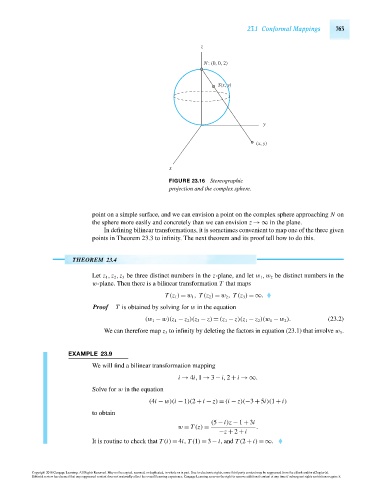Page 783 - Advanced_Engineering_Mathematics o'neil
P. 783
23.1 Conformal Mappings 763
z
N : (0, 0, 2)
S(x, y)
y
(x, y)
x
FIGURE 23.16 Stereographic
projection and the complex sphere.
point on a simple surface, and we can envision a point on the complex sphere approaching N on
the sphere more easily and concretely than we can envision z →∞ in the plane.
In defining bilinear transformations, it is sometimes convenient to map one of the three given
points in Theorem 23.3 to infinity. The next theorem and its proof tell how to do this.
THEOREM 23.4
Let z 1 , z 2 , z 3 be three distinct numbers in the z-plane, and let w 1 ,w 2 be distinct numbers in the
w-plane. Then there is a bilinear transformation T that maps
T (z 1 ) = w 1 , T (z 2 ) = w 2 , T (z 3 ) =∞.
Proof T is obtained by solving for w in the equation
(w 1 − w)(z 1 − z 2 )(z 3 − z) = (z 1 − z)(z 1 − z 2 )(w 1 − w 2 ). (23.2)
We can therefore map z 3 to infinity by deleting the factors in equation (23.1) that involve w 3 .
EXAMPLE 23.9
We will find a bilinear transformation mapping
i → 4i,1 → 3 − i,2 + i →∞.
Solve for w in the equation
(4i − w)(i − 1)(2 + i − z) = (i − z)(−3 + 5i)(1 + i)
to obtain
(5 − i)z − 1 + 3i
w = T (z) = .
−z + 2 + i
It is routine to check that T (i) = 4i, T (1) = 3 − i, and T (2 + i) =∞.
Copyright 2010 Cengage Learning. All Rights Reserved. May not be copied, scanned, or duplicated, in whole or in part. Due to electronic rights, some third party content may be suppressed from the eBook and/or eChapter(s).
Editorial review has deemed that any suppressed content does not materially affect the overall learning experience. Cengage Learning reserves the right to remove additional content at any time if subsequent rights restrictions require it.
October 14, 2010 15:39 THM/NEIL Page-763 27410_23_ch23_p751-788

